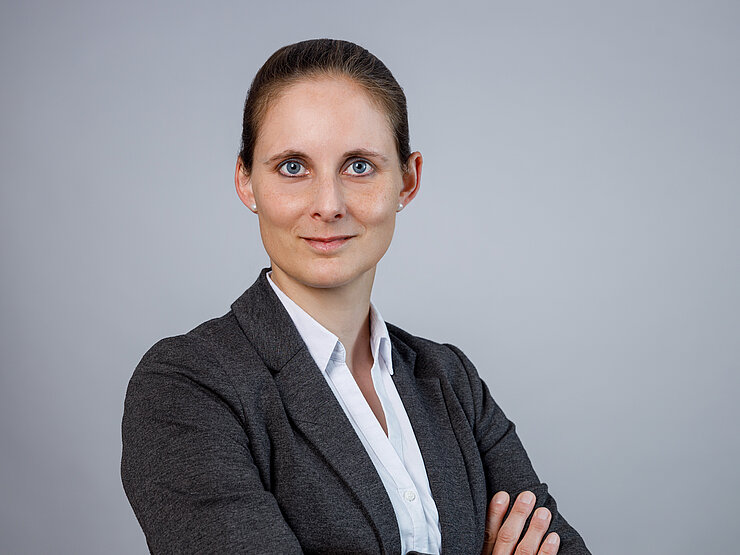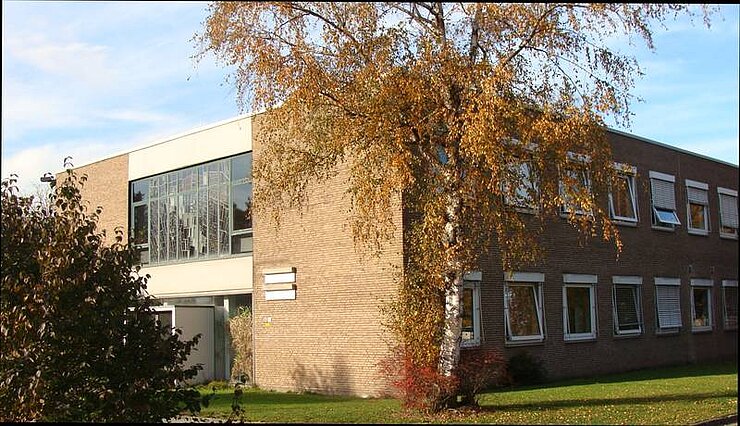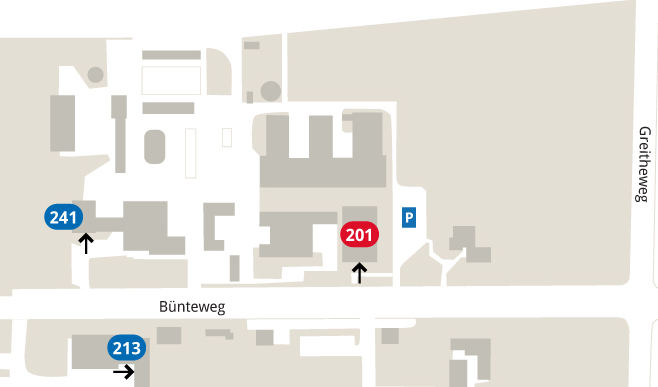![[Translate to English:] DNA](/fileadmin/_processed_/b/2/csm_BG_DNA_8353e009df.jpg)
The genome represents the blueprint for life, for human, domestic animal, wildlife, insect, or infectious agent likewise. The interplay of genes and proteins at the genomic level is complex and regulated by many different processes.
The Institute for Animal Genomics (ITG) embraces the challenge with its interdisciplinary teams to better understand the genome and its functional elements, elucidating their role in the development of specific phenotypes and diseases. Additionally, the institute is at the forefront of developing new bioinformatic methods for analyzing genomic data.
Head of Institute

Research Area of Interest
Lab "Veterinary Functional Genomics"
The research group "Veterinary Functional Genomics" (led by Prof. Dr. Julia Metzger) focuses on the variation and architecture of the genome and its functional elements. The aim of the research group is to understand how sequence variations and structural variations in the genome are encoded, what patterns can be derived from them, and what functional consequences this has on the expression and function of a gene. To comprehend the complex relationships between genotype and phenotype, i.e., the genome and the outward appearance of an organism, the research group employs integrative multi-OMICs approaches, linking laboratory analytical methods with bioinformatic methods in the mammalian model. The group utilizes high-throughput sequencing technologies for targeted capture of gene expression and spatial conformation of chromatin. The focus is particularly on non-coding elements in the genome and their effects on growth and development, determination of body size, skeletal development, and skeletal health. In vitro models from mesenchymal stem cells are created and modified for a deeper understanding of the investigated processes.
Lab "Genomics and Bioinformatics of Infectious Diseases"
The research group "Genomics and Bioinformatics of Infectious Diseases" (led by Prof. Dr. Klaus Jung) explores bioinformatic methods for the analysis of molecular-biological data from high-throughput experiments (OMICs experiments). In these experiments, the expression of thousands of genes simultaneously or genome sequences of entire organisms, for example, using Next-Generation Sequencing or DNA microarray technology, is determined. In their method development, the research group focuses particularly on robust procedures or those aiming for high reproducibility of results. The group draws on classical statistical methods, such as resampling techniques or methods of evidence synthesis (e.g., meta-analyses or the fusion of multiple independent datasets), and adapts them for bioinformatic purposes. The methods are applied specifically to data from infection research. One application focus is viral metagenomics, i.e., the detection of viral sequences in biological samples of infected hosts. Additionally, the research group maintains collaborations with scientists from various fields of biology and medicine, continuously evolving their bioinformatic methods in these projects.
History of the Institute

Animal breeding and genetics have a long-standing tradition: Teaching in animal breeding has existed in Hannover since the founding of the veterinary school in 1778. The chronicle initially mentions the teaching of the conformation of horses and other domestic animals. At that time, breeding essentially meant selecting animals for mating based on their outward appearance.
In 1883, a collection of animal breeding was housed in the Anatomy building. Lectures were given by the head of the Ambulatory Clinic at that time. In 1906, initial efforts were made to approve a new building for animal breeding. The funds were approved in 1912, and in 1918, the first rooms could be used.
The first director of the Institute for Animal Breeding was Carl Kronacher. His goal was to understand the biological foundations of animal breeding, especially genetics. During this time, Ronald Fisher (UK) and Sewall Wright (USA) developed mathematically statistical methods, which were prerequisites for applying new insights in animal breeding and are still used today. Kronacher also dedicated himself to quantitative traits. He also realized that the predisposition of an individual can be determined by examining its offspring.
The Journal for Animal Breeding and Breeding Biology was founded by Carl Kronacher.
The final completion of the institute took place in 1927. Even then, optional excursions to practical farms and public institutions of animal breeding were offered. The institute was heavily damaged during World War II. Reconstruction took place in 1950. In the sixties, Gustav Comberg designed a new institute that met all the requirements of modern research on the breeding of farm animals. In 1967, the new building at the Westfalenhof location was put into use. In 1974, the institute consisted of a director, a department head, seven scientific and fourteen technical staff, and four animal keepers. The Institute for Animal Breeding gave rise to the Institute for Animal Nutrition in 1968 and the Institute for Animal Hygiene in 1976. For a short time, the Institute for Zoology was also housed in animal breeding.
Professor Dr. Hermann Geldermann came to the TiHo in 1977 and researched and taught for over ten years in the field of domestic animal genetics. Prof. Dr. Wilhelm Wegner vehemently opposed cruelty breeding and researched in hereditary pathology. In 1985, Prof. Dr. Detlef Simon from Bonn joined and established the EAAP Data Bank on Animal Genetic Resources. Numerous dissertations concerned endangered animal breeds. The Opti-Mate program was developed for the management of these small breeds. He was the first farmer to become the rector of the TiHo.
In 1997, Prof. Dr. Dr. Ottmar Distl took over as director, shaping the further development of methods and procedures in animal breeding and genomics. In 2019, the institute was newly renovated, and a high-throughput sequencing (NGS) laboratory was established.
In 2015, Prof. Dr. Klaus Jung established the research group "Genomics and Bioinformatics of Infectious Diseases," where new bioinformatic methods for the analysis of complex OMICs data are developed.
The following years marked the reorientation of the institute towards modern OMICs methods, underscored by the opening of the Institute for Animal Genomics. Since 2023, Prof. Dr. Julia Metzger has been the director of the institute, representing the focus area of functional and dynamic regulation of traits and diseases with her research group 'Veterinary Functional Genomics.'
Source: 200 Years of the University of Veterinary Medicine - Presentation of the historical development and current significance of the University of Veterinary Medicine Hannover by Ernst-Heinrich Lochmann. Many thanks to the Institute for History.
Contact
University of Veterinary Medicine Hannover
Bünteweg 17p, Building 201
30559 Hannover
Tel.: +49 511 953-8876
Institute for Animal Genomics
Directions
Navi-Adress: Bünteweg 17p, 30559 Hannover
Public Transport
From the main train station, take U-Bahn (subway) lines 1 (towards Laatzen/Sarstedt),
2 (towards Rethen), or 8 (towards Messe/Nord) for two stops to Aegidientorplatz.
Transfer at Aegidientorplatz and take line 6 (towards Messe/Ost) to the Bünteweg/Tierärztliche Hochschule stop.
The stop is right in front of the administrative building (TiHo-Tower, Bünteweg 2) of the university.
Walk along Bünteweg. You can then take bus lines 373 and 800 (towards Ortsmitte/Mehrum) for one more stop to TiHo/Westfalenhof (approximately 700 meters on foot).
The Institute for Animal Genomics is located on the left side of the street, just behind the bus stop shelter
By car
from the north/west/east
Drive on the "Messeschnellweg"(A37) southbound (towards Messe) and take the exit Bult to exit the expressway. Then, turn left and follow the road towards Bemerode. Bünteweg turns left just after the railway underpass. After approximately 700 meters, you will find the Institute for Animal Genomics on the left side of the street, right at the TiHo/Westfalenhof bus stop.
from the south
On the Messeschnellweg (A37) towards Celle, take the Bult exit and turn right towards Bemerode. Bünteweg turns left just after the railway underpass. After approximately 700 meters, you will find the Institute for Animal Genomics on the left side of the street, right at the TiHo/Westfalenhof bus stop.



